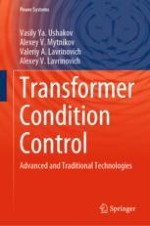This book is devoted to one of the main problems of modern electrical power engineering—power transformer diagnostics. The first three chapters discuss the fundamentals: The first chapter presents the physical reasons for power transformers’ failures and the technical and economic consequences of disruption of the normal operation. The second chapter reviews the standard technologies for monitoring the state of the high-voltage transformers. The third chapter tells about monitoring the condition of transformer windings based on the pulse method.
The fourth chapter presents the technologies for transformer windings condition controlled by means of nanosecond pulses. The stages of improving the pulsed method based on a short probing pulse of the nanosecond range, the results of experiments on identifying the radial and axial displacements of the winding, studies of the effect of the duration and shape of the probing pulse on the sensitivity of the diagnostic procedure, and the stages of developing a mathematical as well as physical model of a power transformer are consistently presented.
